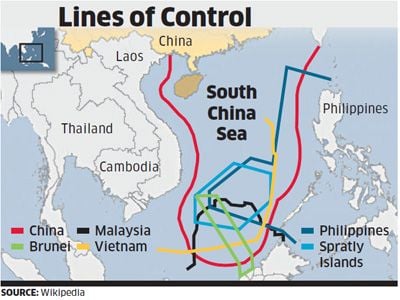China, Vietnam, the Philippines, Taiwan, Malaysia and Brunei, all have been competing for the claim of South China Sea. China’s large military has managed to back its expansive claims on SCS raising concerns with countries like India and The US. While India is worried about China crossing over India’s territorial waters, USA claims ‘Freedom of Navigation’ as their cause.Whatever the reason may be, China and SCS have made international headlines over the issue.
Whatever the reason may be, China and SCS have made international headlines over the issue. Here is what you exactly need to know about this issue majorly explained by BBC:
What is the argument about?
It is a dispute over territory and sovereignty over ocean areas, and the Paracels and the Spratlys – two island chains claimed in whole or in part by a number of countries.
Alongside the fully fledged islands, there are dozens of rocky outcrops, atolls, sandbanks and reefs, such as the Scarborough Shoal.
Why are they worth arguing over?
The sea is a major shipping route and home to fishing grounds that supply the livelihoods of people across the region.
Although largely uninhabited, the Paracels and the Spratlys may have reserves of natural resources around them. There has been a little detailed exploration of the area, so estimates are largely extrapolated from the mineral wealth of neighbouring areas.
Who claims what?
China claims by far the largest portion of territory – an area defined by the “nine-dash line” which stretches hundreds of miles south and east from its most southerly province of Hainan.
Both the Philippines and China lay claim to the Scarborough Shoal or Huangyan Island as it is known in China
Vietnam hotly disputes China’s historical account, saying China had never claimed sovereignty over the islands before the 1940s. Vietnam says it has actively ruled over both the Paracels and the Spratlys since the 17th Century – and has the documents to prove it.
The other major claimant in the area is the Philippines, which invokes its geographical proximity to the Spratly Islands as the main basis of its claim for part of the grouping.
Both the Philippines and China lay claim to the Scarborough Shoal (known as Huangyan Island in China) – a little more than 100 miles (160km) from the Philippines and 500 miles from China.
Malaysia and Brunei also lay claim to territory in the South China Sea that they say falls within their economic exclusion zones, as defined by UNCLOS – the United Nations Convention on the Law of the Sea.
What are the recent developments in the issue?
The most serious trouble in recent decades has flared between Vietnam and China, and there have also been stand-offs between the Philippines and China. Some of the incidents include:
- In 1974 the Chinese seized the Paracels from Vietnam, killing more than 70 Vietnamese troops.
- In 1988 the two sides clashed in the Spratlys, with Vietnam again coming off worse, losing about 60 sailors.
- In early 2012, China and the Philippines engaged in a lengthy maritime stand-off, accusing each other of intrusions in the Scarborough Shoal.
- Unverified claims that the Chinese navy sabotaged two Vietnamese exploration operations in late 2012 led to large anti-China protests on Vietnam’s streets.
- In January 2013, Manila said it was taking China to a UN tribunal under the auspices of the UN Convention on the Laws of the Sea, to challenge its claims.
- In May 2014, the introduction by China of a drilling rig into waters near the Paracel Islands led to multiple collisions between Vietnamese and Chinese ships.
Have they tried to reach a resolution?
China prefers bilateral negotiations with the other parties. But many of its neighbours argue that China’s relative size and clout give it an unfair advantage.
Some countries have argued that China should negotiate with ASEAN (the Association of South East Asian Nations), a 10-member regional grouping that consists of Thailand, Indonesia, Malaysia, the Philippines, Singapore, Brunei, Laos, Vietnam, Myanmar, and Cambodia.
However, China is opposed to this, while Asean is also divided over how to resolve the dispute.
The Philippines have sought international arbitration instead. In 2013, it announced it would take China to an arbitration tribunal under the auspices of the UN Convention on the Laws of the Sea, to challenge its claims.
In July 2016, the tribunal backed the Philippines’ case, saying China had violated the Philippines’ sovereign rights.
China had boycotted the proceedings, and called the ruling “ill-founded”. It says it will not be bound by it.
What should the world expect next?
The dispute between the United States and China is likely to escalate to some degree. U.S. Pacific Command planners are preparing to sail and fly within 12 nautical miles of areas that China claims as sovereign territory. The USS Fort Worth and a P-8 surveillance aircraft have already operated close by, and while China objected, it did not take hostile action.
What is the U.S. response to the dispute?
The United States had virtually no response to the previous building by Southeast Asian countries in the South China Sea but has vigorously opposed China’s efforts. Beyond freedom of navigation missions, the United States is focused on strengthening regional allies. To do so,
it will help boost its allies’ intelligence gathering and surveillance capabilities, and provide them with updated military hardware to counter China’s technical advantages in both quantity and quality.




